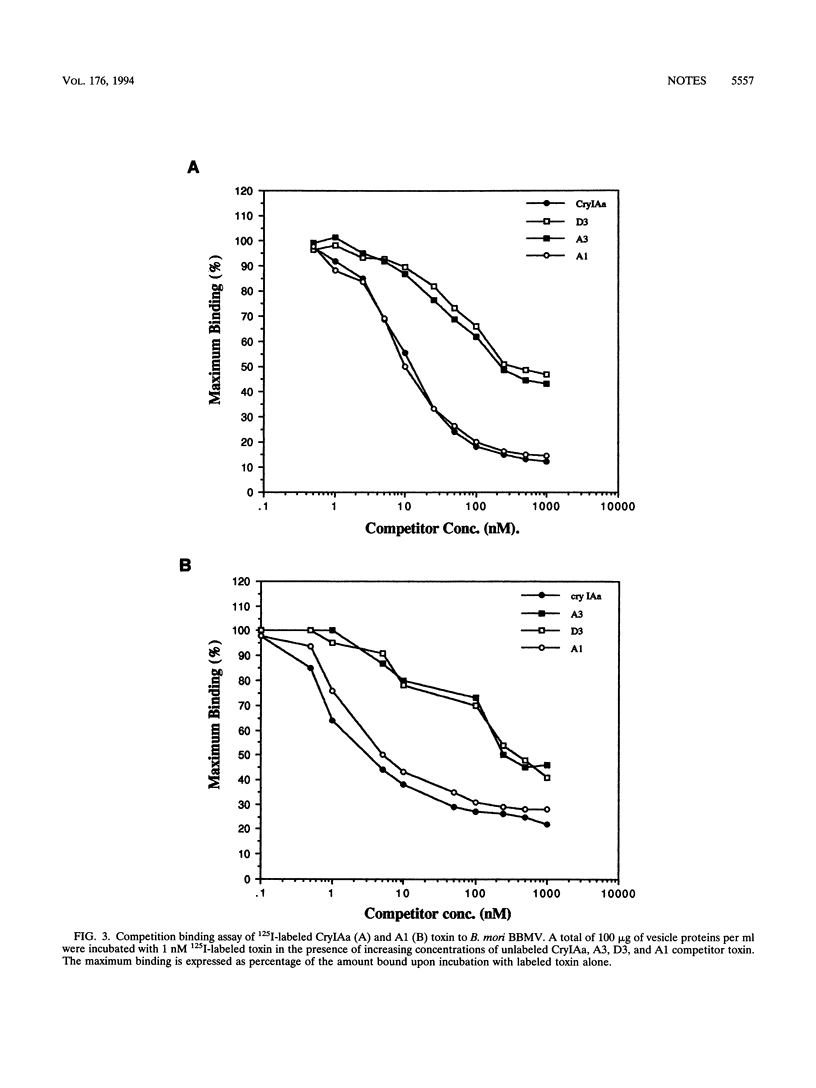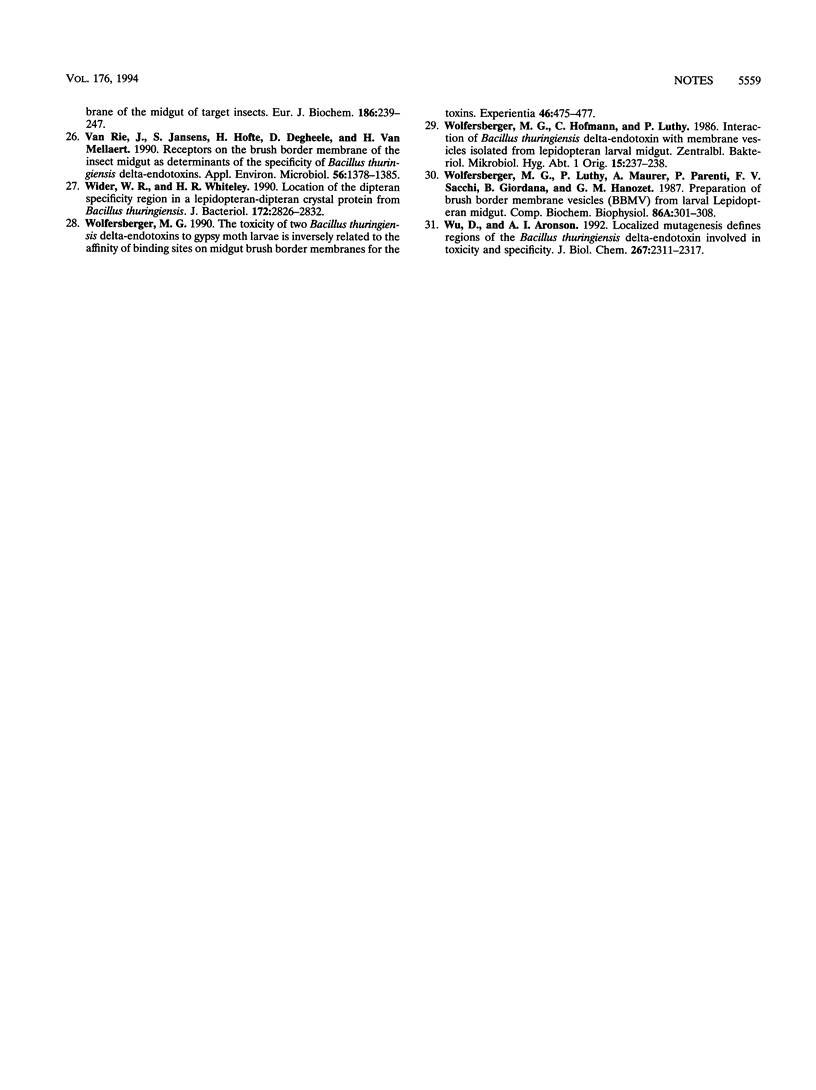Abstract
Alanine substitution (A3) or deletion (D3) of residues 365 to 371 of Bacillus thuringiensis CryIAa insect toxin removed nearly all toxicity for Bombyx mori (> 1,000-fold less active than the wild type). The loss of larvicidal activity in the mutants was not caused by increased sensitivity to larval gut enzymes but could be attributed to significantly reduced binding to B. mori brush border membrane vesicles. Some or all of the affected amino acid residues may interact directly or indirectly with the B. mori membrane receptor(s). Such receptor binding appears to be directly correlated with insect toxicity.
Full text
PDF





Images in this article
Selected References
These references are in PubMed. This may not be the complete list of references from this article.
- Aronson A. I., Beckman W., Dunn P. Bacillus thuringiensis and related insect pathogens. Microbiol Rev. 1986 Mar;50(1):1–24. doi: 10.1128/mr.50.1.1-24.1986. [DOI] [PMC free article] [PubMed] [Google Scholar]
- Garczynski S. F., Crim J. W., Adang M. J. Identification of putative insect brush border membrane-binding molecules specific to Bacillus thuringiensis delta-endotoxin by protein blot analysis. Appl Environ Microbiol. 1991 Oct;57(10):2816–2820. doi: 10.1128/aem.57.10.2816-2820.1991. [DOI] [PMC free article] [PubMed] [Google Scholar]
- Ge A. Z., Rivers D., Milne R., Dean D. H. Functional domains of Bacillus thuringiensis insecticidal crystal proteins. Refinement of Heliothis virescens and Trichoplusia ni specificity domains on CryIA(c). J Biol Chem. 1991 Sep 25;266(27):17954–17958. [PubMed] [Google Scholar]
- Ge A. Z., Shivarova N. I., Dean D. H. Location of the Bombyx mori specificity domain on a Bacillus thuringiensis delta-endotoxin protein. Proc Natl Acad Sci U S A. 1989 Jun;86(11):4037–4041. doi: 10.1073/pnas.86.11.4037. [DOI] [PMC free article] [PubMed] [Google Scholar]
- Harvey W. R., Wolfersberger M. G. Mechanism of inhibition of active potassium transport in isolated midgut of Manduca sexta by Bacillus thuringiensis endotoxin. J Exp Biol. 1979 Dec;83:293–304. doi: 10.1242/jeb.83.1.293. [DOI] [PubMed] [Google Scholar]
- Hodgman T. C., Ellar D. J. Models for the structure and function of the Bacillus thuringiensis delta-endotoxins determined by compilational analysis. DNA Seq. 1990;1(2):97–106. doi: 10.3109/10425179009016037. [DOI] [PubMed] [Google Scholar]
- Hofmann C., Lüthy P., Hütter R., Pliska V. Binding of the delta endotoxin from Bacillus thuringiensis to brush-border membrane vesicles of the cabbage butterfly (Pieris brassicae). Eur J Biochem. 1988 Apr 5;173(1):85–91. doi: 10.1111/j.1432-1033.1988.tb13970.x. [DOI] [PubMed] [Google Scholar]
- Hofmann C., Vanderbruggen H., Höfte H., Van Rie J., Jansens S., Van Mellaert H. Specificity of Bacillus thuringiensis delta-endotoxins is correlated with the presence of high-affinity binding sites in the brush border membrane of target insect midguts. Proc Natl Acad Sci U S A. 1988 Nov;85(21):7844–7848. doi: 10.1073/pnas.85.21.7844. [DOI] [PMC free article] [PubMed] [Google Scholar]
- Honée G., Convents D., Van Rie J., Jansens S., Peferoen M., Visser B. The C-terminal domain of the toxic fragment of a Bacillus thuringiensis crystal protein determines receptor binding. Mol Microbiol. 1991 Nov;5(11):2799–2806. doi: 10.1111/j.1365-2958.1991.tb01988.x. [DOI] [PubMed] [Google Scholar]
- Höfte H., de Greve H., Seurinck J., Jansens S., Mahillon J., Ampe C., Vandekerckhove J., Vanderbruggen H., van Montagu M., Zabeau M. Structural and functional analysis of a cloned delta endotoxin of Bacillus thuringiensis berliner 1715. Eur J Biochem. 1986 Dec 1;161(2):273–280. doi: 10.1111/j.1432-1033.1986.tb10443.x. [DOI] [PubMed] [Google Scholar]
- Laemmli U. K. Cleavage of structural proteins during the assembly of the head of bacteriophage T4. Nature. 1970 Aug 15;227(5259):680–685. doi: 10.1038/227680a0. [DOI] [PubMed] [Google Scholar]
- Lee M. K., Milne R. E., Ge A. Z., Dean D. H. Location of a Bombyx mori receptor binding region on a Bacillus thuringiensis delta-endotoxin. J Biol Chem. 1992 Feb 15;267(5):3115–3121. [PubMed] [Google Scholar]
- Li J. D., Carroll J., Ellar D. J. Crystal structure of insecticidal delta-endotoxin from Bacillus thuringiensis at 2.5 A resolution. Nature. 1991 Oct 31;353(6347):815–821. doi: 10.1038/353815a0. [DOI] [PubMed] [Google Scholar]
- Munson P. J., Rodbard D. Ligand: a versatile computerized approach for characterization of ligand-binding systems. Anal Biochem. 1980 Sep 1;107(1):220–239. doi: 10.1016/0003-2697(80)90515-1. [DOI] [PubMed] [Google Scholar]
- Oddou P., Hartmann H., Radecke F., Geiser M. Immunologically unrelated Heliothis sp. and Spodoptera sp. midgut membrane-proteins bind Bacillus thuringiensis CryIA(b) delta-endotoxin. Eur J Biochem. 1993 Feb 15;212(1):145–150. doi: 10.1111/j.1432-1033.1993.tb17644.x. [DOI] [PubMed] [Google Scholar]
- Sanger F., Nicklen S., Coulson A. R. DNA sequencing with chain-terminating inhibitors. Proc Natl Acad Sci U S A. 1977 Dec;74(12):5463–5467. doi: 10.1073/pnas.74.12.5463. [DOI] [PMC free article] [PubMed] [Google Scholar]
- Schnepf H. E., Tomczak K., Ortega J. P., Whiteley H. R. Specificity-determining regions of a lepidopteran-specific insecticidal protein produced by Bacillus thuringiensis. J Biol Chem. 1990 Dec 5;265(34):20923–20930. [PubMed] [Google Scholar]
- Schwartz J. L., Garneau L., Masson L., Brousseau R. Early response of cultured lepidopteran cells to exposure to delta-endotoxin from Bacillus thuringiensis: involvement of calcium and anionic channels. Biochim Biophys Acta. 1991 Jun 18;1065(2):250–260. doi: 10.1016/0005-2736(91)90237-3. [DOI] [PubMed] [Google Scholar]
- Schwartz J. L., Garneau L., Savaria D., Masson L., Brousseau R., Rousseau E. Lepidopteran-specific crystal toxins from Bacillus thuringiensis form cation- and anion-selective channels in planar lipid bilayers. J Membr Biol. 1993 Feb;132(1):53–62. doi: 10.1007/BF00233051. [DOI] [PubMed] [Google Scholar]
- Slatin S. L., Abrams C. K., English L. Delta-endotoxins form cation-selective channels in planar lipid bilayers. Biochem Biophys Res Commun. 1990 Jun 15;169(2):765–772. doi: 10.1016/0006-291x(90)90397-6. [DOI] [PubMed] [Google Scholar]
- Vadlamudi R. K., Ji T. H., Bulla L. A., Jr A specific binding protein from Manduca sexta for the insecticidal toxin of Bacillus thuringiensis subsp. berliner. J Biol Chem. 1993 Jun 15;268(17):12334–12340. [PubMed] [Google Scholar]
- Van Rie J., Jansens S., Höfte H., Degheele D., Van Mellaert H. Receptors on the brush border membrane of the insect midgut as determinants of the specificity of Bacillus thuringiensis delta-endotoxins. Appl Environ Microbiol. 1990 May;56(5):1378–1385. doi: 10.1128/aem.56.5.1378-1385.1990. [DOI] [PMC free article] [PubMed] [Google Scholar]
- Widner W. R., Whiteley H. R. Location of the dipteran specificity region in a lepidopteran-dipteran crystal protein from Bacillus thuringiensis. J Bacteriol. 1990 Jun;172(6):2826–2832. doi: 10.1128/jb.172.6.2826-2832.1990. [DOI] [PMC free article] [PubMed] [Google Scholar]
- Wolfersberger M. G. The toxicity of two Bacillus thuringiensis delta-endotoxins to gypsy moth larvae is inversely related to the affinity of binding sites on midgut brush border membranes for the toxins. Experientia. 1990 May 15;46(5):475–477. doi: 10.1007/BF01954236. [DOI] [PubMed] [Google Scholar]
- Wu D., Aronson A. I. Localized mutagenesis defines regions of the Bacillus thuringiensis delta-endotoxin involved in toxicity and specificity. J Biol Chem. 1992 Feb 5;267(4):2311–2317. [PubMed] [Google Scholar]
- van Frankenhuyzen K., Gringorten J. L., Milne R. E., Gauthier D., Pusztai M., Brousseau R., Masson L. Specificity of Activated CryIA Proteins from Bacillus thuringiensis subsp. kurstaki HD-1 for Defoliating Forest Lepidoptera. Appl Environ Microbiol. 1991 Jun;57(6):1650–1655. doi: 10.1128/aem.57.6.1650-1655.1991. [DOI] [PMC free article] [PubMed] [Google Scholar]




